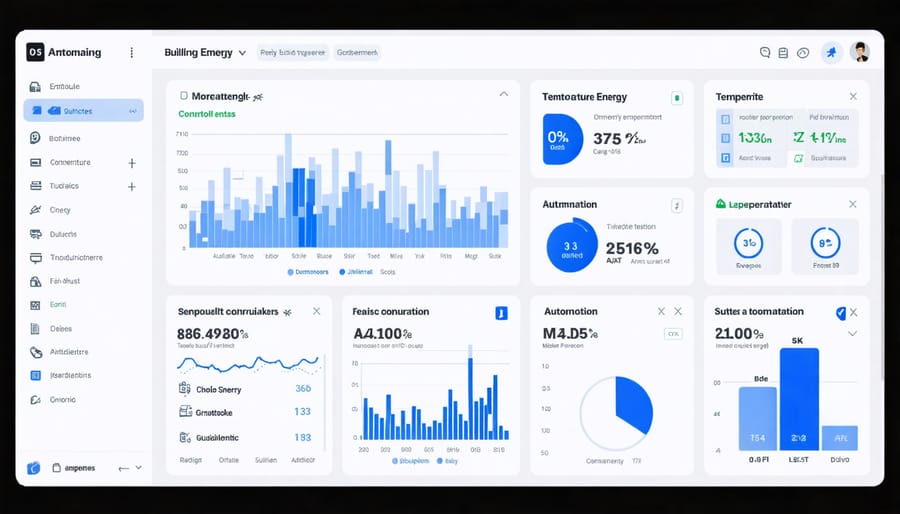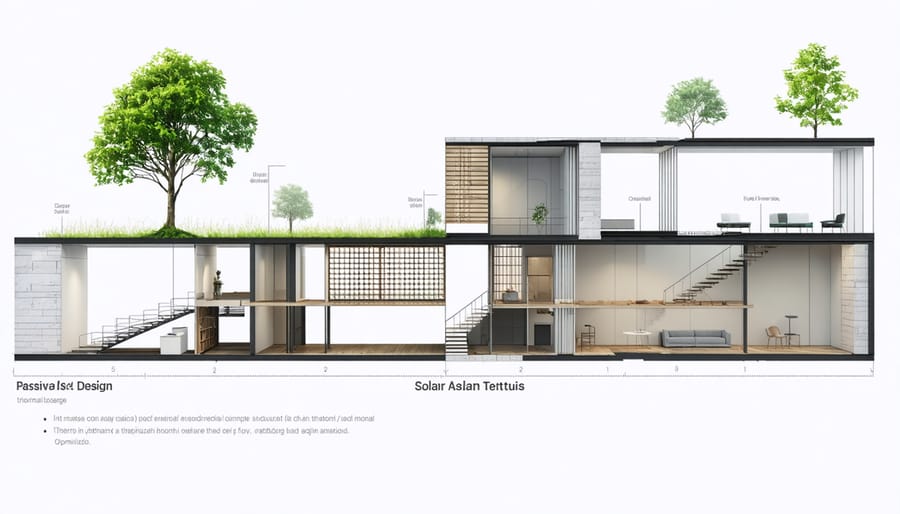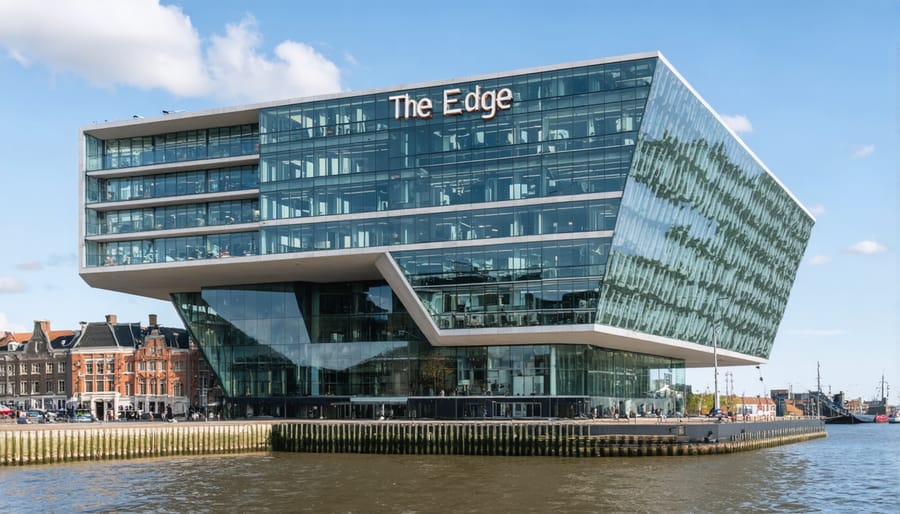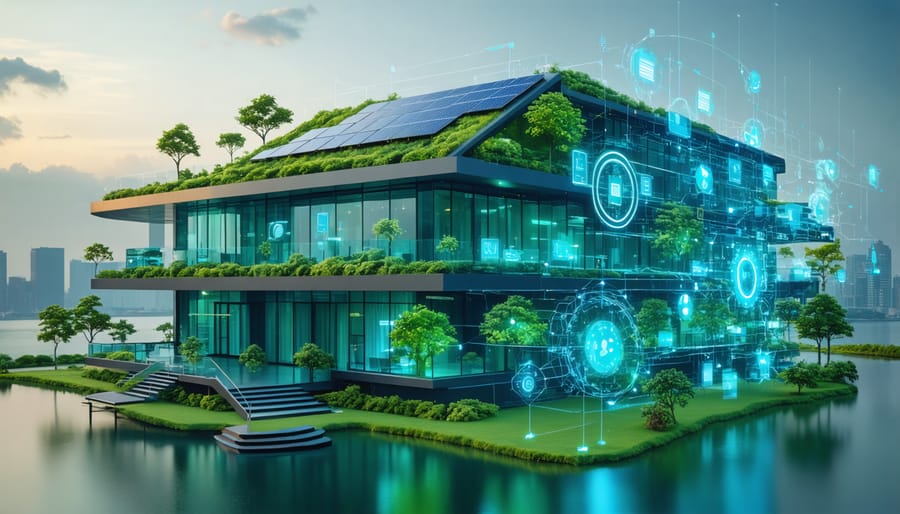Building energy optimization stands at the forefront of modern construction innovation, driving operational efficiency while addressing urgent environmental challenges. As global energy costs surge and sustainability regulations tighten, optimizing building energy performance has evolved from a desirable feature to a critical business imperative. Industry leaders report energy savings of 20-50% through comprehensive optimization strategies, transforming how we design, construct, and operate commercial and residential structures.
The convergence of advanced IoT sensors, machine learning algorithms, and building automation systems has revolutionized our approach to energy management. These technologies enable real-time monitoring and predictive analytics, allowing facility managers to identify inefficiencies and implement data-driven solutions. Studies from the Department of Energy demonstrate that intelligent building systems can reduce energy consumption by up to 30% while improving occupant comfort and productivity.
For construction professionals and building owners, the implications are clear: implementing robust energy optimization strategies not only reduces operational costs but also enhances property value and ensures compliance with increasingly stringent environmental regulations. As we navigate the challenges of climate change and resource scarcity, building energy optimization represents not just an opportunity for immediate cost savings, but a fundamental shift in how we conceive and manage our built environment.
This crucial intersection of technology, sustainability, and economic efficiency demands a thorough understanding of current best practices and emerging innovations in building energy optimization.
Advanced Building Energy Management Systems (BEMS)

AI-Driven Energy Control Systems
Artificial intelligence has revolutionized building energy management through sophisticated control systems that continuously analyze and optimize energy consumption patterns. Modern buildings are implementing AI-driven energy optimization solutions that leverage machine learning algorithms to predict usage patterns, adjust HVAC operations, and maintain optimal comfort levels while minimizing energy waste.
These intelligent systems process data from thousands of sensors throughout the building, including occupancy detectors, temperature sensors, and energy meters. By analyzing this information in real-time, AI controllers can make split-second decisions about energy distribution, reducing consumption by 20-30% compared to traditional building management systems.
Recent implementations at commercial facilities have demonstrated remarkable results. The Edge building in Amsterdam, for example, utilizes AI-powered systems that learn from occupant behavior and weather patterns to automatically adjust lighting, heating, and cooling settings. This advanced approach has helped the building achieve unprecedented energy efficiency ratings.
Key capabilities of AI energy control systems include:
– Predictive maintenance scheduling
– Dynamic load balancing
– Automated fault detection
– Real-time energy consumption optimization
– Occupancy-based environmental control
These systems continue to evolve, incorporating more sophisticated algorithms and deeper learning capabilities that enable buildings to become increasingly self-optimizing over time. The integration of AI with existing building management systems has proven to be a crucial step toward achieving net-zero energy goals in modern construction projects.
IoT Integration for Real-Time Monitoring
IoT integration has revolutionized building energy management by enabling real-time monitoring and automated response systems. Advanced sensor networks now collect comprehensive data on temperature, humidity, occupancy patterns, and energy consumption across building zones. These interconnected devices form a sophisticated mesh of data points that provide facility managers with unprecedented visibility into building performance.
Modern IoT systems typically incorporate multiple sensor types, including smart meters, occupancy sensors, and environmental monitoring devices. These components communicate through secure protocols, transmitting data to centralized building management systems (BMS) for analysis and action. The real-time nature of this data collection allows for immediate responses to changing conditions, such as adjusting HVAC settings based on actual occupancy rather than predetermined schedules.
Case studies have shown that IoT-enabled buildings can achieve energy savings of 15-30% through optimized operations. For instance, a commercial office building in Singapore implemented an IoT monitoring system that reduced energy consumption by 25% within the first year of operation. The system’s predictive maintenance capabilities also helped prevent equipment failures and reduced maintenance costs by 20%.
Key considerations for IoT implementation include sensor placement strategy, network security protocols, and data management systems. Successful deployments require careful planning of the sensor network architecture and integration with existing building systems. Regular calibration and maintenance of sensors ensure data accuracy and system reliability, while robust cybersecurity measures protect against potential vulnerabilities in the connected infrastructure.

Passive Design Strategies
Thermal Mass Optimization
Thermal mass optimization plays a crucial role in building energy efficiency by leveraging materials’ natural ability to absorb, store, and release heat. High-density materials such as concrete, stone, and brick effectively regulate indoor temperatures by absorbing excess heat during peak hours and releasing it during cooler periods, reducing HVAC load requirements.
Strategic placement of thermal mass elements is essential for maximum effectiveness. In cold climates, positioning thermal mass materials to receive direct sunlight through south-facing windows optimizes passive solar heating. For warm climates, protecting thermal mass from direct solar gain while ensuring adequate nighttime ventilation enables effective heat dissipation.
Recent innovations in phase change materials (PCMs) have expanded thermal mass applications. These materials, integrated into building elements, can store and release large amounts of energy while transitioning between solid and liquid states, providing enhanced temperature regulation with minimal spatial requirements.
Case studies demonstrate that properly implemented thermal mass strategies can reduce heating and cooling costs by 20-30%. For instance, the Meyer Science Center achieved a 25% reduction in HVAC energy consumption through strategic thermal mass integration combined with night-flush ventilation systems. The key to success lies in early-stage planning and careful material selection based on local climate conditions and building use patterns.
Natural Ventilation Systems
Natural ventilation systems represent a cornerstone of sustainable building design, utilizing atmospheric pressure differences and thermal buoyancy to create air movement without mechanical assistance. These systems can reduce HVAC energy consumption by 20-30% when properly implemented, making them a crucial component of energy-efficient building strategies.
Key natural ventilation approaches include cross ventilation, stack ventilation, and wind towers. Cross ventilation leverages pressure differentials between building facades, requiring strategic window placement and interior layout optimization. Stack ventilation exploits the natural tendency of warm air to rise, utilizing thermal chimneys or atria to create vertical air movement.
Implementation success depends on careful consideration of local climate conditions, building orientation, and occupancy patterns. Advanced computational fluid dynamics (CFD) modeling helps optimize ventilation pathways and predict system performance. Notable examples include the CH2 Building in Melbourne, which combines wind towers with shower towers to achieve optimal thermal comfort while reducing cooling costs by 65%.
To maximize effectiveness, natural ventilation systems should be integrated with automated building management systems that respond to temperature, humidity, and CO2 levels. This integration ensures optimal performance while maintaining occupant comfort and meeting indoor air quality standards throughout varying seasonal conditions.
Active Energy Optimization Technologies
Smart HVAC Solutions
Modern HVAC systems represent a cornerstone of building energy optimization, combining sophisticated controls with intelligent automation to maximize efficiency. Advanced Building Management Systems (BMS) integrate with HVAC components to create dynamic, responsive environments that adjust in real-time to occupancy patterns, weather conditions, and thermal loads.
Variable Air Volume (VAV) systems, coupled with smart sensors and predictive analytics, enable precise zone-by-zone temperature control while minimizing energy waste. These systems can reduce energy consumption by 20-30% compared to traditional constant-volume systems. Heat recovery ventilation (HRV) and energy recovery ventilation (ERV) technologies further enhance efficiency by capturing and reusing thermal energy from exhaust air.
The implementation of machine learning algorithms in HVAC control systems has revolutionized building climate management. These systems learn from historical data and occupancy patterns to optimize start-up times, adjust temperature setpoints, and predict maintenance needs. Recent case studies demonstrate that AI-driven HVAC optimization can achieve energy savings of up to 40% while maintaining or improving occupant comfort.
Demand-controlled ventilation (DCV) systems, using CO2 sensors and occupancy detection, automatically adjust fresh air intake based on actual building usage. This targeted approach ensures optimal air quality while preventing the energy waste associated with over-ventilation. When combined with modern electronically commutated motors (ECMs) and variable frequency drives (VFDs), these systems provide unprecedented levels of control and efficiency in building operations.

LED Lighting and Automated Controls
LED lighting systems, combined with automated controls, represent one of the most cost-effective strategies for reducing building energy consumption. Modern LED fixtures consume up to 75% less energy than traditional incandescent bulbs while offering superior light quality and longer operational lifespans of up to 50,000 hours.
Smart lighting controls enhance these efficiency gains through multiple features. Occupancy sensors automatically adjust lighting levels based on space utilization, while daylight harvesting systems modulate artificial lighting in response to natural light availability. Advanced building management systems (BMS) integration enables granular control over lighting zones and schedules, ensuring optimal energy usage across different areas and times of day.
Recent innovations include tunable white LED systems that adjust color temperature throughout the day to support occupant circadian rhythms while maintaining energy efficiency. Power over Ethernet (PoE) lighting solutions further streamline installation and enable detailed energy monitoring at the fixture level.
Implementation case studies consistently demonstrate ROI periods of 2-4 years for LED retrofits with smart controls. A recent commercial office project in Chicago achieved a 62% reduction in lighting energy consumption through the combination of LED fixtures and automated controls, resulting in annual savings of $47,000.
For maximum effectiveness, lighting systems should be commissioned properly and integrated with other building systems. Regular maintenance and periodic recommissioning ensure sustained performance and energy savings over time.

Case Study: The Edge Building, Amsterdam
The Edge, located in Amsterdam’s Zuidas business district, stands as a testament to what’s possible in building energy optimization, achieving an unprecedented BREEAM sustainability score of 98.36% – the highest ever awarded. Completed in 2015, this 40,000-square-meter office building demonstrates how intelligent design and advanced technology can create a near-zero energy building.
The building’s energy efficiency stems from multiple innovative systems working in harmony. The south-facing wall features solar panels, while the north facade maximizes natural light penetration. An aquifer thermal energy storage system, extending 129 meters below ground, helps manage heating and cooling requirements, reducing energy consumption by 60% compared to conventional office buildings.
What sets The Edge apart is its network of approximately 28,000 sensors that continuously monitor occupancy, movement, lighting levels, humidity, and temperature. This smart system adjusts the building’s energy usage in real-time, ensuring optimal efficiency. The LED lighting system, powered by low-voltage electricity through Ethernet cables, automatically adjusts based on occupancy and natural light levels, consuming 50% less energy than traditional lighting solutions.
Rainwater harvesting and recycling systems further enhance sustainability, reducing water consumption by 70%. The building’s orientation and double-skin facade maximize natural ventilation, while solar panels on neighboring buildings contribute to the energy network, helping achieve energy-neutral operations.
The results speak for themselves: The Edge produces more electricity than it consumes, with an energy consumption of just 0.3 kWh per square meter per year. This performance has set new benchmarks for sustainable architecture and demonstrates the ROI potential of comprehensive energy optimization strategies. The initial investment in these systems was recovered within three years through reduced operational costs and enhanced property value.
The Edge serves as a blueprint for future sustainable buildings, proving that with the right combination of design, technology, and systems integration, near-zero energy consumption is achievable in large-scale commercial buildings.
Implementation and ROI Analysis
Successfully implementing energy optimization strategies requires a structured approach combining technical expertise with sound financial planning. Our analysis of successful projects reveals that organizations typically achieve optimal results through a four-phase implementation process: assessment, planning, execution, and monitoring.
The initial assessment phase involves conducting comprehensive energy audits, typically costing between $0.10 and $0.40 per square foot, depending on building complexity. This investment typically yields detailed insights that inform subsequent optimization decisions and helps identify quick wins with immediate returns.
For ROI calculations, consider both direct and indirect benefits:
Direct Financial Returns:
– Energy cost savings (typically 20-30% in the first year)
– Maintenance cost reduction (average 15% decrease)
– Equipment lifecycle extension (25-40% longer operational life)
– Utility incentives and tax benefits (varying by region)
Indirect Benefits:
– Increased property value (3-7% premium)
– Enhanced tenant satisfaction
– Improved workplace productivity
– Reduced carbon footprint
Our case studies indicate that most building optimization projects achieve payback periods between 2-5 years, with an average ROI of 15-25%. More aggressive implementations incorporating advanced technologies like AI-driven systems can see ROIs exceeding 30%, though initial investments are higher.
Key implementation considerations include:
1. Phased deployment to manage cash flow
2. Staff training and change management
3. Performance measurement protocols
4. Continuous commissioning plans
For optimal results, establish clear baseline measurements before implementation and implement robust monitoring systems. Modern building management systems (BMS) typically cost $2.50-$7.00 per square foot but can reduce energy consumption by up to 45% when properly implemented.
Consider financing options such as energy performance contracts (EPCs), which can eliminate upfront costs while guaranteeing savings. Many projects also qualify for government incentives, green building certifications, and carbon credit programs, further improving financial returns.
Regular performance reviews and adjustments ensure optimization strategies remain effective and continue delivering expected returns. Document all improvements and maintain detailed records for future reference and potential certification requirements.
Building energy optimization has emerged as a critical factor in modern construction and facility management, driven by the dual imperatives of environmental sustainability and operational cost reduction. Throughout this exploration, we’ve seen how integrated approaches combining advanced technologies, smart systems, and sustainable practices can dramatically improve building performance and energy efficiency.
The future of building energy optimization looks increasingly promising, with emerging technologies like artificial intelligence and machine learning poised to revolutionize how we manage building systems. These innovations will enable more precise control, predictive maintenance, and automated optimization of energy consumption patterns. The integration of IoT sensors and big data analytics will further enhance our ability to make data-driven decisions for energy management.
Industry trends suggest that the focus will continue to shift toward holistic optimization strategies that consider the entire building lifecycle, from design and construction to operation and maintenance. The growing adoption of green building standards and stricter energy regulations worldwide will drive further innovations in this field.
For construction professionals and building owners, the key takeaway is clear: investing in energy optimization is no longer optional but essential for long-term success. The demonstrated ROI from implemented projects, combined with increasing energy costs and environmental regulations, makes a compelling case for proactive adoption of energy optimization strategies.
As we move forward, collaboration between architects, engineers, and facility managers will become even more crucial in delivering energy-efficient buildings that meet both environmental goals and occupant needs while maintaining operational excellence.

